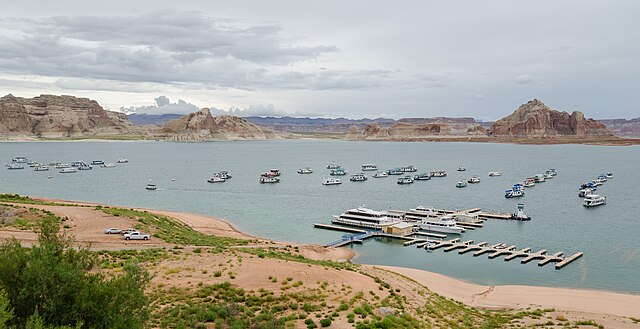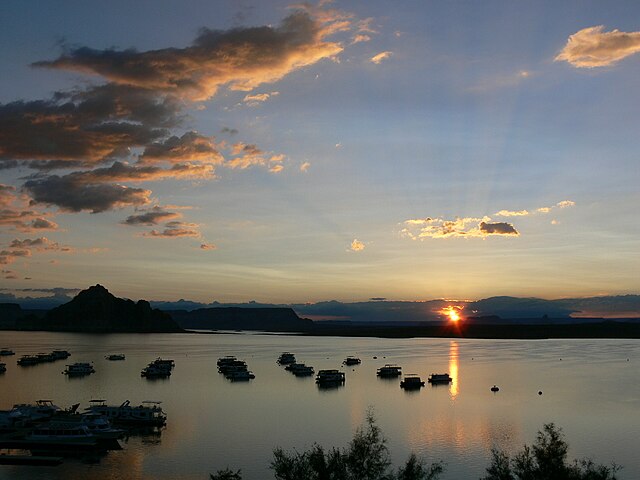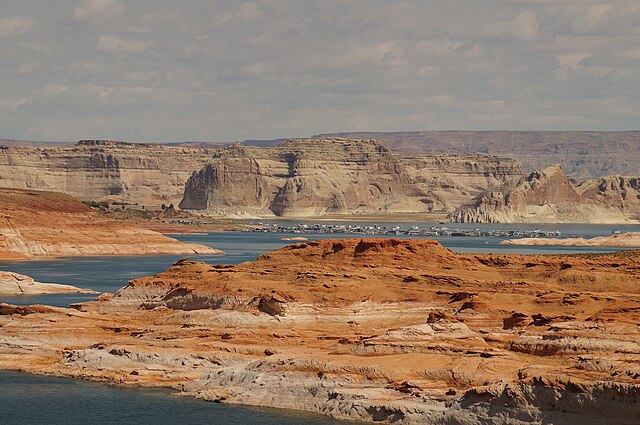Lake Powell, that stunning man-made reservoir straddling the Utah-Arizona border, is more than just a pretty place to snap Instagram-worthy photos. It’s a lifeline for millions, powering homes, irrigating crops, and drawing adventure-seekers to its turquoise waters. But if you’ve been keeping an eye on the news, you’ve probably heard whispers about its fluctuating water levels. So, what’s the deal? Why does Lake Powell’s water level keep yo-yoing, and what does it mean for travelers, locals, and the environment? Let’s dive into the story of this iconic lake, explore its challenges, and uncover what 2025 has in store.
The Heart of the Colorado River: Lake Powell’s Role
Picture Lake Powell as the beating heart of the Colorado River system. Created in the 1960s by the Glen Canyon Dam, this reservoir doesn’t just store water—it’s a critical cog in the machine that supplies water to seven states and Mexico. It powers the Glen Canyon hydropower plant, keeps farms green, and ensures cities like Phoenix and Las Vegas don’t go thirsty. But here’s the catch: its water levels are like a rollercoaster, rising and falling with the whims of Mother Nature and human demands. In 2025, the lake’s story is one of cautious optimism, but the challenges are far from over.
Why Lake Powell Matters
Ever wonder why a lake in the middle of the desert gets so much attention? Lake Powell holds up to 24.3 million acre-feet of water when full, making it the second-largest reservoir in the U.S., just behind Lake Mead. It’s a key player in the Colorado River Compact, ensuring Upper Basin states (Colorado, Utah, Wyoming, New Mexico) deliver a steady flow to the Lower Basin (Arizona, Nevada, California). Plus, it’s a recreational hotspot, pulling in about two million visitors annually for boating, fishing, and jaw-dropping views. When water levels drop, it’s not just a lake problem—it’s a regional crisis.
A Quick Look at the Numbers
As of July 2025, Lake Powell’s water level hovers around 3,550 feet above sea level, about 150 feet below its full pool of 3,700 feet. That’s roughly 31% of its capacity, a slight dip from its peak of 3,587 feet in July 2024. Compare that to its record low of 3,521.77 feet in February 2023, and you can see it’s been a wild ride. These numbers aren’t just stats—they tell a story of drought, recovery, and the delicate balance of water management.
The Drought That Shook the Southwest

For over two decades, the American Southwest has been grappling with a megadrought, one of the worst in centuries. Imagine a relentless sun baking the land, shrinking snowpacks in the Rockies, and leaving rivers like the Colorado gasping for water. Since 2000, Lake Powell’s levels have plummeted, hitting critical lows in 2022. Why? Less snowmelt, hotter temperatures, and a growing thirst for water from cities and farms. It’s like trying to fill a bucket with a hole in it—nature just isn’t keeping up.
How Climate Change Plays a Role
Climate change is the uninvited guest at this party. Rising temperatures mean less snow in the Rockies, and what does fall melts earlier, rushing into rivers before it can be stored effectively. Scientists predict a potential 20% drop in Colorado River flow by 2050. That’s like turning down the tap on a resource millions depend on. Add in evaporation from scorching desert heat, and Lake Powell loses water faster than a leaky faucet.
Human Demand: The Other Culprit
It’s not just nature’s fault. Humans have been sipping from the Colorado River like it’s an endless milkshake. Agriculture, urban growth, and hydropower needs have stretched the river thin. The Lower Basin states, in particular, have historically overused their share, creating a “structural deficit” that keeps Lake Powell from rebounding fully, even in wet years. It’s a classic case of wanting more than what’s available.
The Rebound: Hope on the Horizon
Now, let’s talk good news. In 2023, a record-breaking snowpack in the Rockies sent a flood of water into Lake Powell, boosting levels by over 60 feet. Conservation efforts kicked into high gear, too, with Arizona, Nevada, and California slashing water use to historic lows. By July 2024, the lake hit 3,587 feet, its highest in three years. It’s like the lake got a much-needed drink after years of thirst. But is this recovery here to stay, or is it just a temporary reprieve?
Conservation Efforts Making a Difference
Think of water conservation like a team sport. States, farmers, and cities have stepped up, cutting consumption through innovative programs. Arizona and Nevada hit their lowest water use since the 1990s, and California’s not far behind. Federal funding has fueled projects like drying up irrigated lands temporarily to save water. These efforts are like plugging the holes in that bucket, giving Lake Powell a fighting chance.
The Role of Snowpack and Runoff
Snowpack is Lake Powell’s lifeline. When the Rockies get blanketed in snow, the spring melt feeds the Colorado River, which in turn fills the lake. In 2024, snowpack was above average, pushing water levels up. But 2025 forecasts are less rosy, with runoff projected at just 55% of average due to a lackluster winter. It’s like hoping for a big rain but getting a drizzle—every drop counts, but it might not be enough.
Ecological Impacts: Nature’s Comeback

Low water levels aren’t all bad news. As Lake Powell shrinks, parts of Glen Canyon, submerged since the 1960s, are reemerging. Native plants are popping up, creating vibrant ecosystems where invasive species once ruled. It’s like nature hitting the reset button, turning barren lakebeds into thriving oases. But this ecological rebirth comes with a catch—rising water could drown these new habitats, sparking debates about whether to keep the lake low.
The Rise of Native Species
Imagine a desert canyon suddenly bursting with green. That’s what’s happening in Glen Canyon. Native plants like willows and cottonwoods are reclaiming exposed lakebeds, creating homes for wildlife. Researchers are thrilled, noting that these areas are thriving without human help. It’s a reminder that nature is resilient, but it also raises questions about balancing water storage with ecological preservation.
Invasive Species and Challenges
Not everything blooming is good news. Invasive plants like tamarisk and Russian thistle can creep in, threatening native ecosystems. The Bureau of Reclamation is keeping an eye on these invaders, but controlling them is like trying to weed a garden the size of a small country. It’s a delicate dance to protect this reborn landscape while managing water needs.
Lake Powell is a playground for boaters, anglers, and adventurers. But low water levels have thrown a wrench into the fun. Boat ramps have closed, marinas have shifted, and some spots are now high and dry. Yet, the lake’s beauty remains, and 2025 is still a great time to visit—if you know how to plan. So, how can you make the most of a trip to Lake Powell?
Boating and Marinas in 2025
Boating is the heart of Lake Powell’s appeal, but low water levels mean longer ramps and fewer access points. Antelope Point Marina, for instance, relies on a 1,600-foot concrete ramp to reach the water. The good news? Recent rises have reopened key spots like the ferry between Hall’s Crossing and Bullfrog Marina. Check marina conditions before you go, and consider guided tours to navigate tricky waters.
Tips for Visitors
Planning a trip? Stay flexible. Water levels can change fast, so check updates from the National Park Service or sites like Lakes Online. Kayaking and hiking are great alternatives if boating’s tough, and the exposed canyon landscapes offer new views. Pack for hot weather, bring plenty of water, and watch for advisories like the 2025 toxic algae bloom warning. It’s like planning a picnic—you need to be ready for unexpected rain.
The Future of Lake Powell: What’s Next?

The crystal ball for Lake Powell is cloudy. With a 2026 deadline looming for new Colorado River management agreements, tensions are high. Upper and Lower Basin states are at odds over water cuts, and climate change adds uncertainty. Will the lake ever reach full capacity again? Probably not without a string of wet years. But adaptive management, new tech, and cooperation could keep it stable.
New Water Management Strategies
The Bureau of Reclamation is tweaking guidelines to balance Lake Powell and Lake Mead. Ideas like wastewater recycling (potentially saving 900,000 acre-feet annually) and smarter irrigation are gaining traction. It’s like teaching an old dog new tricks—challenging but possible. Federal and state collaboration will be key to avoiding court battles that could stall progress.
Can Technology Save the Day?
From advanced water monitoring to desalination, technology offers hope. Imagine sensors tracking snowmelt in real-time or systems recycling wastewater for cities. These innovations could ease the strain on Lake Powell, but they’re not silver bullets. It’s like adding a turbo engine to a car—it helps, but you still need a good driver.
Conclusion: A Lake Worth Saving
Lake Powell’s story is one of resilience, challenge, and hope. Its water levels reflect the broader struggle of the Colorado River Basin, where drought, demand, and climate change collide. Yet, with conservation, cooperation, and a bit of luck from Mother Nature, this iconic reservoir can continue to thrive. Whether you’re a boater, an environmentalist, or just someone who loves a good view, Lake Powell’s fate matters. So, let’s keep the conversation going, support smart water policies, and plan that trip to see its beauty for yourself. What will you discover on its shores?
Frequently Asked Questions
1. Why are Lake Powell’s water levels so low?
A megadrought since 2000, reduced snowpack, and high water demand from cities and farms have caused levels to drop. Climate change makes it worse by reducing runoff and increasing evaporation.
2. Is it safe to visit Lake Powell in 2025?
Yes, but check for advisories like toxic algae blooms. Boating may be trickier due to low water, so plan with updated marina and ramp info.
3. How does Lake Powell’s water level affect hydropower?
Low levels threaten the Glen Canyon Dam’s ability to generate electricity. If levels drop below 3,490 feet, the turbines can’t operate, impacting power for millions.
4. What’s being done to save Lake Powell?
Conservation programs, reduced water use by states, and federal guidelines are helping. Wastewater recycling and better irrigation practices are also in the works.
5. Can Lake Powell ever return to full capacity?
It’s unlikely without several wet years in a row. Current levels are about 31% of capacity, and climate models suggest ongoing challenges, but conservation could stabilize it.

